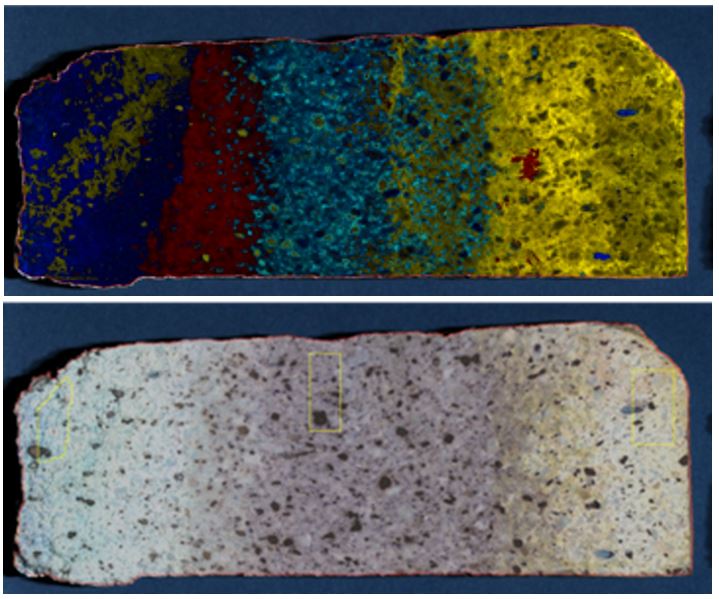Our Samples in the Light of Science

Our team at HySpex in Norway got the samples from Leoben about two weeks ago. When samples like these reach our laboratory we first take some time to get familiar with their details. What do the samples represent, what do the labels mean, and what are we trying to learn from these samples? Our typical laboratory setup is a combination of two different cameras that collect data for us.
Our data is called “hyperspectral data”. That means that we can see a lot more details than what a normal camera would see. Our cameras collect the light that is reflected from a sample surface. This light travels as particles and waves, when we look at light travelling as waves the length of each wave changes. We are collecting the light in different wavelengths across a larger range and to that precisely we are using our HySpex cameras, which are built precisely for that purpose. With our cameras, we can see the visible wavelength range (what our eyes can perceive). Red, green and blue colours are part of the wavelength range from 400 – 700 nanometers. And we also collect longer wavelength ranges up to 2500 nanometers (that’s 0.00025 centimetres).
How we measure the samples is referred to as “scanning” as our cameras are collecting one line at a time and build an image by moving the sample underneath the cameras. They work differently than customary photography equipment that is collecting the incoming light in 3 bands (red – green – blue) in a pixel grid. What makes hyperspectral cameras unique for material identification is that the incoming light is split into a lot of small bands, representing narrow wavelength regions. For example, with our SWIR (short-wave infrared) camera, we are collecting the incoming light in ca. 4 nanometer (nm) wide bands from 1000 – 2500nm that overlap. This results in more than 400 bands across 400 – 2500nm to be collected per each individual pixel.
We are collecting this data so precisely because it enables us to say something about the composition of the material. When light from a light source comes into contact with a surface it reacts differently depending on what the surface is made of and how it’s structured. Light has three main interactions with a sample surface, it can be reflected back, it can be absorbed and it can be transmitted (=travel through the surface). We are collecting the portion of the light that is reflected back from the sample surface into our cameras. How much light is reflected back and in which wavelength regions tells us something about the element or molecular structure of the sample and can for example help us to identify different minerals.
In the next couple of months, we are going to go through the data that my colleagues collected with our instruments and analyse it based on its spectral characterists. We want to find out if different materials in these bricks have different spectral fingerprints by which we can identify them easily and if those can help us to develop a solution that helps us to sort the different bricks that we expect into different recycling fractions or qualities. This is the main goal of ReSource. From a very quick and dirty analysis that we’ve done already, you can see that the slice of a brick on the right looks like it has three to four different colours from the top to down. When we look at the image next to it, which is based on our data, you can see that there is a lot more variety and different areas that we could not pick up with the naked eye, represented by the different colours. This already helps us to understand the bricks better.

Author’s Portrait
Friederike Koerting
Dr. Friederike Koerting is working for HySpex by Norsk Elektro Optikk AS as the Geological Hyperspectral Application Specialist. HySpex by NEO is the industry-leading brand for airborne and ground-based hyperspectral imaging and is a manufacturer of advanced electro-optical products.
Friederike is applying hyperspectral imaging to help miners mitigate risks, unlock value and save time. She enjoys communicating with and to users from research and industry alike, furthering her understanding of their needs, and the possible impact of applying HySpex solutions has on users. Friederike is passionate about creating accessible platforms with a user-first mindset and establishing long-lasting channels of communication for discussions and insights. She aims to apply her expertise in the field of technology-driven sustainable mining with a regard to environmental preservation and protection. That ultimately led her to start working for HySpex in April 2021 and for her to join the ReSoURCE project activities.